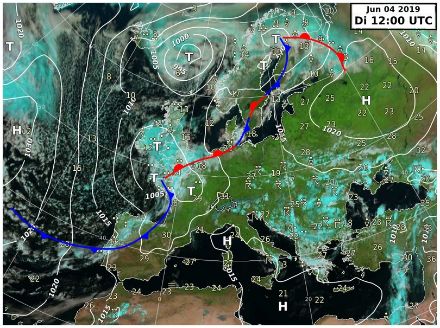Service Navigation
Search
The southwesterly flow is similar to a westerly flow, but the centres of activity (highs and lows) shift. Switzerland is usually subject to a southwesterly flow when the Azores high in the Atlantic shifts westwards and there is a low over the nearby Atlantic, extending towards the Iberian Peninsula. This flow carries mild, damp sea air into Switzerland. Precipitation is less common when the flow is determined by an area of high pressure. On the other hand, it rains more frequently when the flow is determined by an area of low pressure. If the flow is heading in a more southerly direction, then warm, subtropical air is carried to Switzerland.
Mild and damp in winter
In winter, southwesterly flows are the most dynamic. The weather is usually cloudy on the southern side of the Alps and in the west of the country with precipitation. Depending on the temperature of the air mass, heavy snowfall can occur on the western and southern slopes of the Alps. Temperatures are generally above average. The wind tends to blow in a southwesterly direction at higher altitudes and over the Swiss plateau. When the pressure is higher over the southern side of the Alps, the southerly foehn tends to blow in the Alpine valleys on the northern side of the Alps. In the northeastern part of the country, the sky clears and the region is largely spared precipitation.

Frequent thunderstorms and precipitation in summer
Southwesterly flows are less common in summer than in winter, and much less dynamic. This means that the winds are weaker in summer. The air mass is warm and unstable, which provides the right conditions for showers and thunderstorms to form in most regions.
